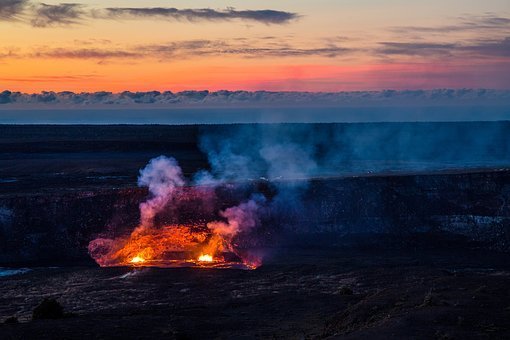Two Year Anniversary Kīlauea Volcano Eruption 2018
Two Year Anniversary Kīlauea Volcano Eruption 2018
I still remember the Kīlauea 2018 eruption, which destroyed homes, polluted the air, and provided fascinating pictures and videos of the awesome power of Mother Nature. The eruption was associated with earthquakes every day, sometimes one hundred small earth quakes a day. It was many months of a surreal existence which was confined to one island in the Hawaiian Island chain, the Big Island of Hawaii.
This is a short pictorial history of some of the events of that eruption. @shortsegments
Kilauea volcano erupts!
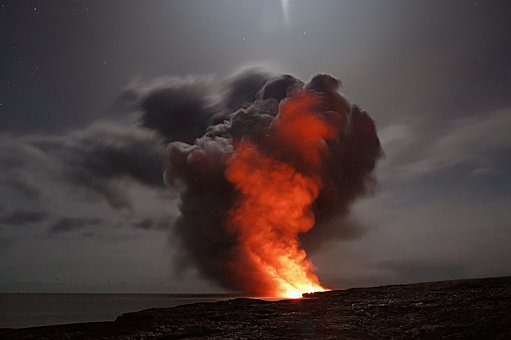 )
)
Picture courtesy of USGS United States Geological Society
Where in the world is the Big Island of Hawaii and the Kīlauea volcano? It's here👇
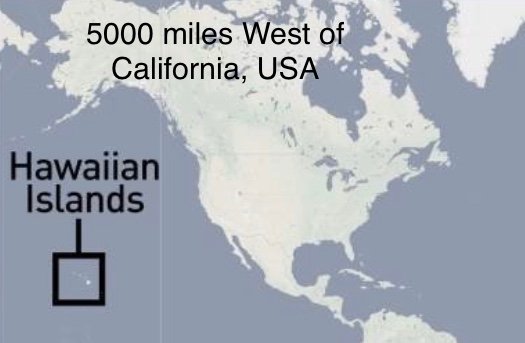
Picture courtesy of USGS United States Geological Society
The Hawaiian Island chain stretched for many miles and 128 islands, but the main island is 5000 miles west of North America, in a subtropical location.
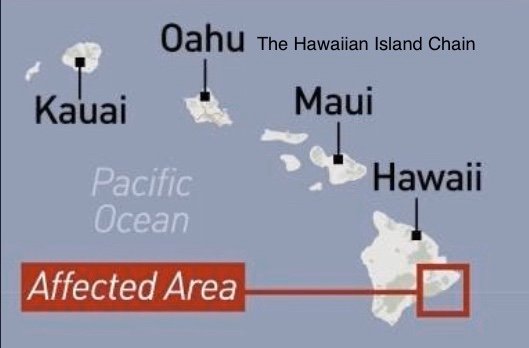
Picture courtesy of USGS United States Geological Society
This is the main island chain with population of over one million people.
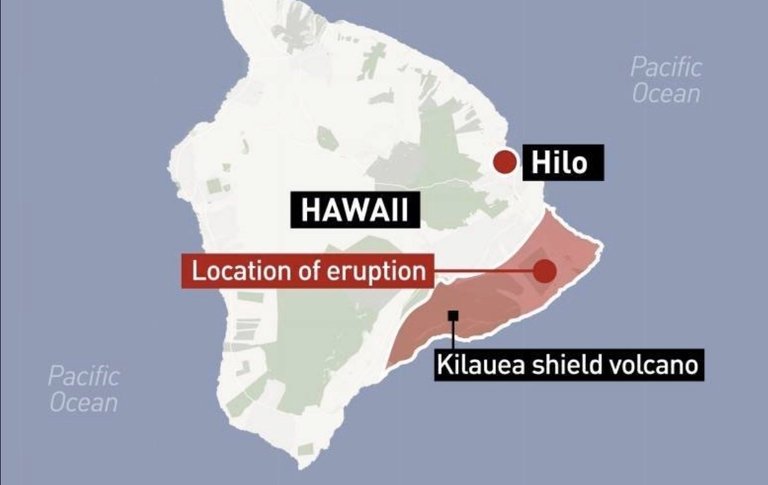
Picture courtesy of USGS United States Geological Society
This is the Big Island with three active volcanos. The one which erupted is called Kīlauea. Lava can choose to exit a Volcanos through underground pipes called “lava tubes” and these tubes sometimes open on the surface of the planet and give off steam, but sometimes there are eruptions of lava such as this eruption. These vents can come to the surface many miles from the Volcano such as this eruption as indicated on this map.
Kilauea volcano full of hot melted lava
Kilauea volcano hot lava at night

Picture courtesy of USGS United States Geological Society
The melted lava is 2,200 degrees F or 1,200 degrees Celsius.
Kilauea volcano hot lava at sunset time
On May 4, 2018, there was an explosion in a volcanic vent and a large pillar of red-brown ash cloud could be seen from a few miles away.👇
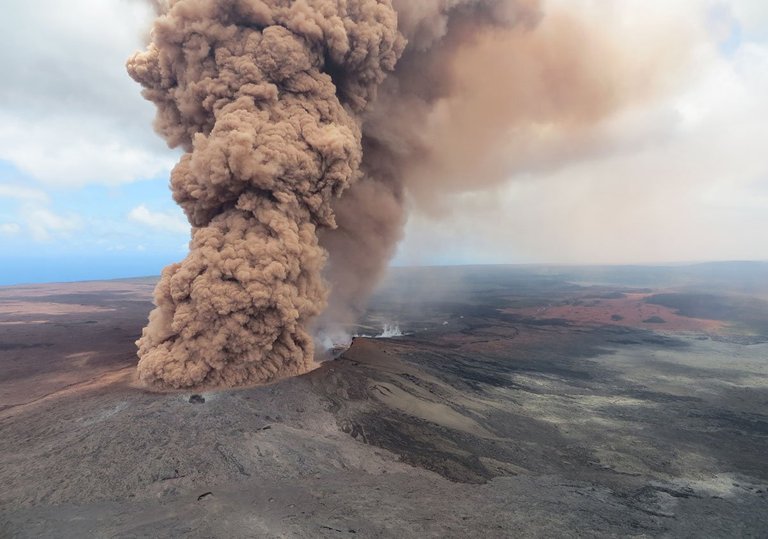
This happened after a 6.9 magnitude earthquake shook the Big Island of Hawaii.
This is another view of this same eruption as seen from Kalapana, Hawaii which is many miles away.👇
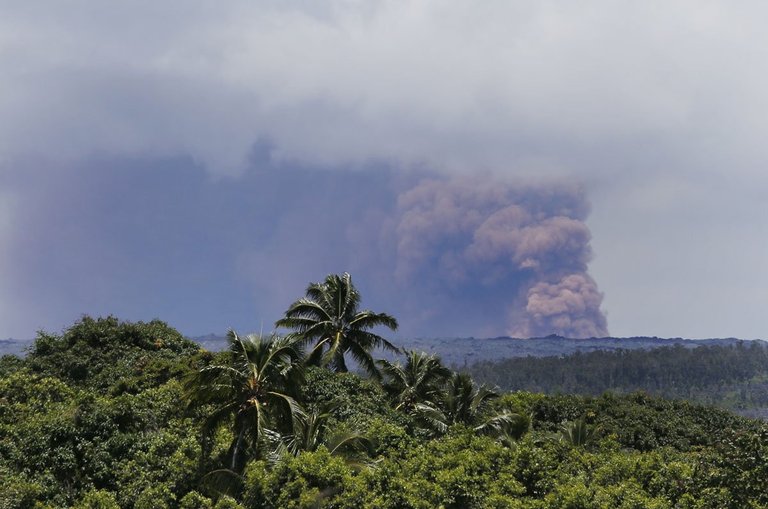
Photo By Marco Garcia / AP and Atlantic Magazine
A little background information...
The volcano erupts and lava flows from its cracks. This lava rolls down the mountain on its way to the ocean. It is a moving river of liquid stone 2000 degrees Celsius. Everything solid thing the lava touches melts or bursts into flames. It pours into lakes and the lake water boils off as steam, soon the lake is filled with lava and the lava moves on towards the sea. An unrelenting flow which can’t be diverted or extinguished.
This makes for unusual pictures as lava tolls through the forests and towns.
What does lava look like when it rolls through forests, across roads and stacks up on the street in residential areas?
It looks like this! 👇
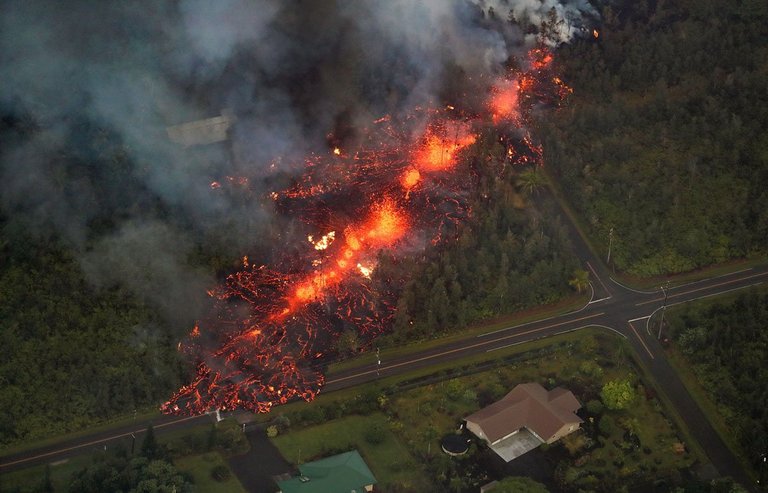
Photo By Bruce Omori / Paradise Helicopters / EPA-EFE / REX / Shutterstock
This lava moving through the forest at night
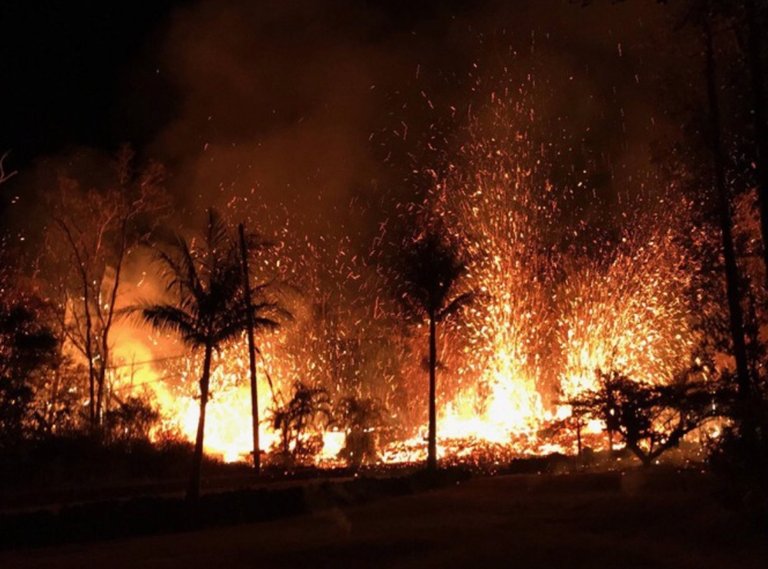
This is lava crossing the road.

Photo By Byron Matthews via AP and Atlantic Magazine
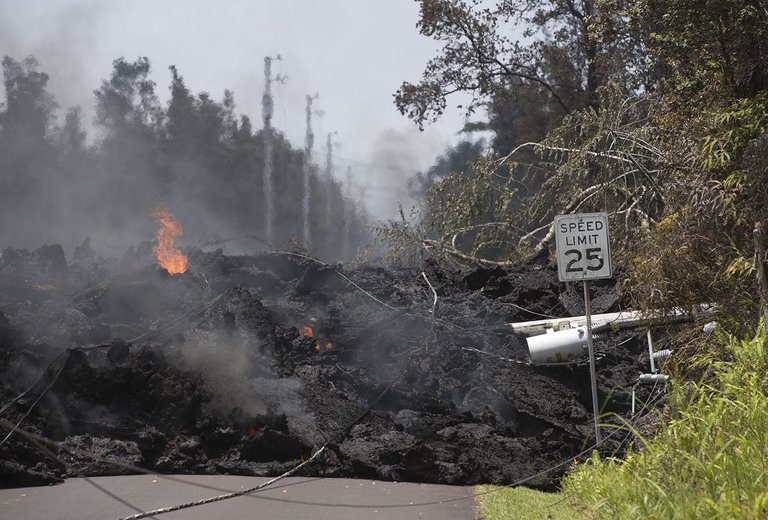
Photo By Marco Garcia / AP and Atlantic Magazine

Picture courtesy of USGS United States Geological Society
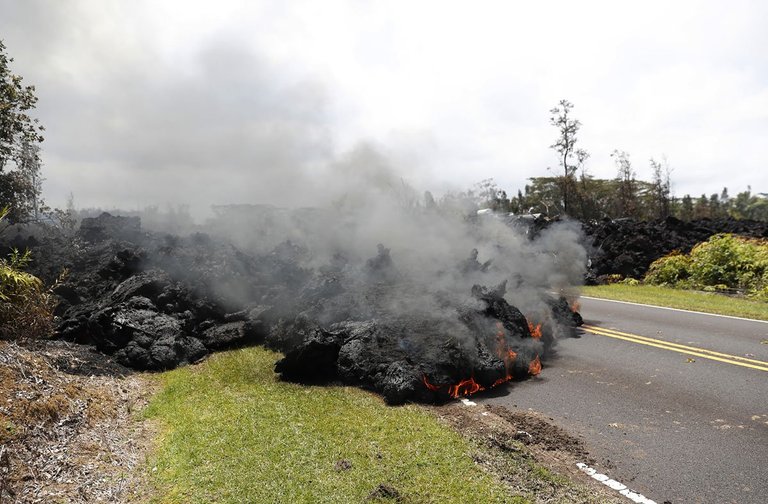
Picture courtesy of USGS United States Geological Society
Lava doesn’t look hot, but anything that touches it bursts into flames. You see small flames where things fell on the rolling lava and caught fire immediately.
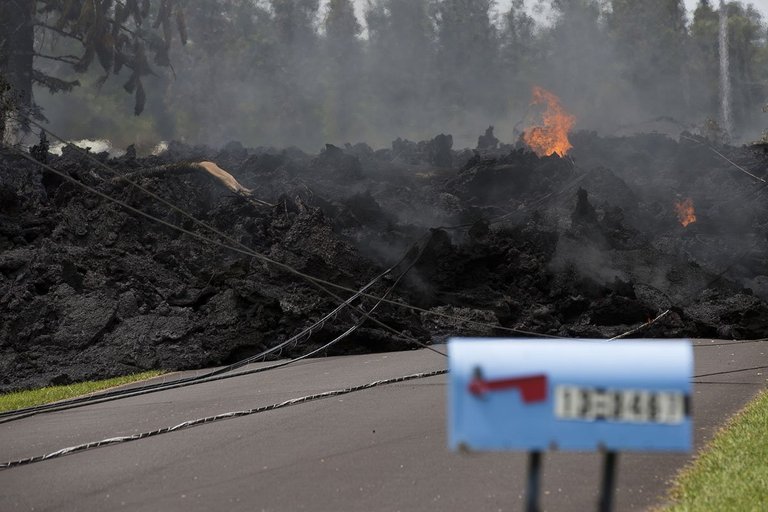
Picture courtesy of USGS United States Geological Society
Lava doesn’t look hot, but anything that touches it bursts into flames. You see small flames where things fell on the rolling lava and caught fire immediately.
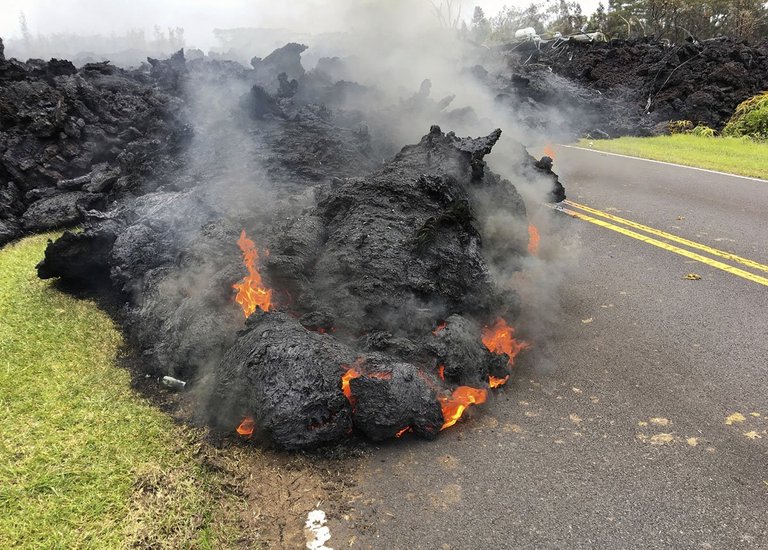
Photo By Marco Garcia / AP and Atlantic Magazine
Lava is like a bulldozer and flamethrower in one, it rolls along as a 6-12 foot wall of liquid molten rock flattening and carrying burning debris with it as it rolls through an area.
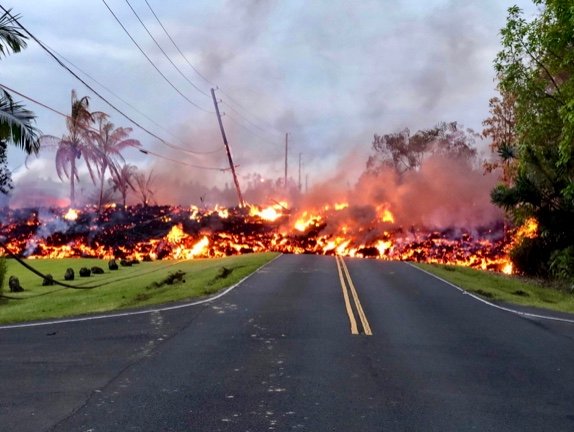
Lava doesn’t just move along the surface it moves under ground in “lava tubes”. This movement is associated with earthquakes, cracks in the road, fissures, steam vents and lava fountains.
In Hawaii we have earthquakes during the volcano eruptions. These cause cracks in the roads. 👇

Cracks
These are annoying, and bumpy, but easily coveted by metal plates.
Fissures
These are much more serious, as these are cracks in underground lava tubes! The lava escapes moving upward to the surface of the earth. It heats up any moisture in the ground causing steam to come out of these cracks. The steam is dangerous, as it causes severe burns!
Lava Fountains.
The next dangerous thing about fissures is lava shoots out of them. Literally hot streams of 2000 degree lava shifting 80-100 meters in the air. It’s crazy!
Those innocent looking steam vents can turn into this:

Picture courtesy of National Park Service
Then the lava tips open the earth and instead of a small crack you have a gaping wound in the earth 10-20 feet across and the lava starts it’s journey yo the sea forming rivers of lava.
The below video from the National Park Service and is part of public domain. This gives a view of an actual lava fountain erupting from large fissures! This is about 53 seconds long.
And of course the lava flows down hill to the ocean. This United States Geologic Service USGS video is public domain and shows a lava vent dumping into the ocean. This is about one minute long.
The earth is a wonder ours place filled with amazing things to experience. Volcanos are one such fascinating natural phenomenon. I hope you enjoyed the post.
Written by Shortsegments.
Pictures & references
- Atlantic Magazine Kilauea Lava flow on the Big Island of Hawaii
https://www.theatlantic.com/photo/2018/05/photos-of-Kilaueas-newest-lava-fissures-on-hawaiis-big-island/559751/ - USGS Volcano Hazards Program
https://volcanoes.usgs.gov/volcanoes/kilauea/geo_hist_summary.html - Geological survey of the United States
https://www.usgs.gov/ - CBS News Science Behind Hawaii Volcanoes
https://www.cbsnews.com/news/hawaii-kilauea-volcano-lava-science/ - USA Today: Science Behind Hawaii Volcanoes
https://www.usatoday.com/story/news/nation/2018/05/07/hawaii-volcano-science-behinder-eruption-kilauea/586268002/ - LA Times: The science behind volcanic activity on Hawaii's Big Island
http://www.latimes.com/visuals/graphics/la-na-hawaii-volcano-explainer-20180509-htmlstory.html - Trip advisor visiting Kilauea volcano on the Big Island of Hawaii
https://www.tripadvisor.com/Attraction_Review-g29217-d105294-Reviews-Kilauea_Volcano-Island_of_Hawaii_Hawaii.html - CBS News Science Behind Hawaii Volcanoes
http://www.cbc.ca/news/technology/kilaue-a-cano-hawaii-1.4651710 - National Geographic Magazine: Science, Myths of the Kilauea Volcano
https://news.nationalgeographic.com/2018/05/kilaue-a-volcano-tsunami-explosive-hawaii-myths-explained-science/
#appreciator @appreciator
#rocky1 @rocky1
#upmewhale @upmewhale
#tipu @tipu
#curangel @curangel
#bdvoter @bdvoter
#theycallmedan @theycallmedan
#tarazkp @tarazkp
#galenkp @galenkp
#payroll
#redpalantino
#neoxian
Two Year Anniversary Kīlauea Volcano Eruption 2018

